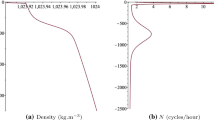Abstract
In the context of modeling internal water waves, some strongly nonlinear reduced models exhibit a nonlocal term involving a Hilbert-type transform. These models accurately account for the physical dispersion regarding the Euler equations. To perform a careful stability analysis and detect whether numerical solutions are reliable or spurious, it is necessary to adapt the classical von Neumann analysis to account for nonlocal dispersive terms. We address this issue by a fully discrete analysis of the one-dimensional linear model, in the flat bottom case. We find a formula for the amplification factor that provides estimates concerned with numerical stability and dispersion (namely, phase errors). Subsequently, we contrast the numerical properties of the original dispersive problem with that of the underlying non-dispersive case, namely a linear hyperbolic system. The stability estimates corroborate the fact that physical dispersion provided by a nonlocal (singular integral) term allows for less restrictive stability conditions.








Similar content being viewed by others
References
Ascher U (2008) Numerical methods for evolutionary differential equations. SIAM, Philadelphia
Baker G, Nachbin A (1998) Stable methods for vortex sheet motion in the presence of surface tension. SIAM J Sci Comput 19(5):1737–1766
Beale J, Hou T, Lowengrub J (1996) Convergence of a boundary integral method for water waves. SIAM J Numer Anal 33(5):1797–1843
Bona J, Chen M, Saut JC (2002) Boussinesq equations and other systems for small-amplitude long waves in nonlinear dispersive media. I: Derivation and linear theory. J Nonlinear Sci 12(4):283–318
Camassa R, Choi W, Michallet H, Rusås PO, Sveen JK (2006) On the realm of validity of strongly nonlinear asymptotic approximations for internal waves. J Fluid Mech 549:1–23
Choi W, Camassa R (1999) Fully nonlinear internal waves in a two-fluid system. J Fluid Mech 396:1–36
Choi W, Barros R, Jo TC (2009) A regularized model for strongly nonlinear internal solitary waves. J Fluid Mech 629:73–85
Debsarma S, Das KP, Kirby JT (2010) Fully nonlinear higher-order model equations for long internal waves in a two-fluid system. J Fluid Mech 654:281–303
Grajales Muñoz JC, Nachbin A (2006) Improved Boussinesq-type equations for highly variable depth. IMA J Appl Math 71(4):600–633
Iório R, Iório V (2001) Fourier analysis and partial differential equations. Cambridge University Press, Cambridge
Keener JP (2000) Principles of applied mathematics. Transformation and approximation. Westview Press, Cambridge
Levy D, Tadmor E (1998) From semidiscrete to fully discrete: Stability of Runge-Kutta schemes by the energy method. SIAM Rev 40(1):40–73
Milewski P, Tabak E, Turner C, Rosales R, Menzaque F (2004) Nonlinear stability of two-layer flows. Commun Math Sci 2:427–442
Oliveira SP, Ruiz de Zárate A, Rocha AC, Alfaro Vigo DG (2013) A note on the alternate trapezoidal quadrature method for Fredholm integral eigenvalue problems. Numer Algorithms 62(4):601–614
Ruiz de Zárate A (2007) A reduced model for internal waves interacting with submarine structures at intermediate depth. Technical Report. C 55/2007, Instituto de Matemática Pura e Aplicada, Rio de Janeiro, Brazil. http://www.preprint.impa.br/Shadows/SERIE_C/2007/55.html
Ruiz de Zárate A, Nachbin A (2008) A reduced model for internal waves interacting with topography at intermediate depth. Commun Math Sci 6:385–396
Ruiz de Zárate A, Alfaro Vigo DG, Nachbin A, Choi W (2009) A higher-order internal wave model accounting for large bathymetric variations. Stud Appl Math 122:275–294
Strikwerda JC (2004) Finite difference schemes and partial differential equations, 2nd edn. SIAM, Philadelphia
Trefethen LN (2000) Spectral methods in Matlab. SIAM, Philadelphia
Vichnevetsky R, Bowles JB (1982) Fourier analysis of numerical approximations of hyperbolic equations. SIAM, Philadelphia
Author information
Authors and Affiliations
Corresponding author
Additional information
Communicated by Abimael F. D. Loula.
This work was funded by CNPq under grant 482081/2009-0. A. N. and S. O. are supported by CNPq under grants 300368/96-8 and 314553/2009-6.
Proof of Theorem 2
Proof of Theorem 2
Our proof of Theorem 2 is based on the Fourier Series framework provided in Iório and Iório (2001). Similar arguments have been previously employed in Bona et al. (2002) for a class of Boussinesq systems.
Proof
Proceeding as in Lemma 2, we find
where \(\kappa =k\pi /l\) and the matrix function \(A(\kappa )\) is defined in Eq. (38). Moreover, it follows from Eq. (8) that
whereas \(G\left( t,\kappa \right) \) can be written as \(G\left( t,\kappa \right) =V(\kappa ) \,\tilde{G}(t,\kappa ) \,V^{-1}(\kappa )\), where
We have \(\Vert A(\kappa )G\left( t,\kappa \right) A^{-1}(\kappa )\Vert _2 \le \Vert A(\kappa )V(\kappa )\Vert _2\Vert (A(\kappa )V(\kappa ))^{-1}\Vert _2\), i.e.,
Taking into account that the function \(\phi \) defined in Eq. (5) satisfies \(|\kappa |\le \phi (\kappa )\le 1+|\kappa |\), we can find the following upper bound for the inequality (43):
The inequality (13) follows from choosing \(C\) as the above upper bound. Analogously, for the persistence property (14) we can prove that
where the constant \(\tilde{C}>0\) does not depend on \(t\), thus using the Weierstrass M-test we conclude that \([\partial _t^r \eta (t,x), \partial _t^r u(t,x)]^{T} \in C([0,\infty ); H^{(s-r/2,s+1/2-r/2)})\). \(\square \)
Rights and permissions
About this article
Cite this article
Alfaro Vigo, D.G., Oliveira, S.P., Ruiz de Zárate, A. et al. Fully discrete stability and dispersion analysis for a linear dispersive internal wave model. Comp. Appl. Math. 33, 203–221 (2014). https://doi.org/10.1007/s40314-013-0056-0
Received:
Revised:
Accepted:
Published:
Issue Date:
DOI: https://doi.org/10.1007/s40314-013-0056-0




